Greek Custard Pie (Galaktoboureko)
It’s funny, I do so much baking and have a never-ending list of recipes that I want to try and experiment with, but on some days it’s like I hit a total roadblock. I’m not sure what I want to make, nothing sounds good to me on that particular day, and I’m just sort of stuck. Enter my Chief Culinary Consultant. He’s awesome at thinking outside of the box and coming up with great ideas that often times elude me. So was the case right after New Year’s when I was doing some planning for the month of January and everything was just feeling “eh” to me. I was staring at a mile-long list of food ideas, but wasn’t feeling anything. He hopped on his phone, did some Googling, and started throwing out some new and fresh ideas. I could barely write them down fast enough. One of the ones he threw out was this Greek custard pie. He stumbled upon a recipe for it and after reading the ingredients, knew immediately we would love it. I couldn’t get to the kitchen fast enough for this one, and his intuition was definitely spot-on – we adored this!
In addition to the delicious factor, I was excited about my first-ever experiment with an authentic Greek dish in my kitchen. I have always enjoyed traditional Greek foods when eating out, especially spanakopita, moussaka and baklava, and had no doubt I would enjoy this. After checking out numerous recipes online, many of them being similar, I settled on this one because of the back story. The blogger actually ate this at the home of her in-laws in Greece and received the recipe from a cousin. Nothing warms my foodie heart quite like an old-fashioned family recipe.
As with any recipe that involves working with phyllo dough, the preparation takes some time but the end product is no doubt well worth it. Layers of crispy, buttery, flaky pastry that is light as air. Absolutely worth it. The custard in this dish actually has a very similar flavor to the filling of a sfogliatelle (the Italian pastry that I still have yet to master) – both use semolina as a thickening agent and have a faint citrus undertone. I always keep semolina on hand for dusting my pizza peel when I make homemade pizza; I usually find it at a local Italian grocery store.
All-in-all this is not a difficult recipe, but it includes a few steps and layering phyllo dough can be slightly time-consuming. Trust me, it’s a small price to pay for the the wow factor this dessert delivers. For some step-by-step photos of the assembly process, be sure to check out Whipped (link is below the recipe) – she did a great job.
Do you have a favorite Greek recipe (sweet or savory)?
One year ago: Nut Rolls
Four years ago: Banana Muffins
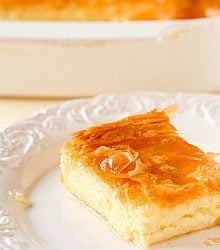
Greek Custard Pie (Galaktoboureko)
Ingredients
Custard:
- 6 cups (1.46 l) whole milk
- 1 cup (167 g) fine semolina
- ¾ cup (150 g) granulated sugar, divided
- 1 tablespoon unsalted butter
- 1 teaspoon vanilla extract
- 3 eggs
- Zest of 1 orange
Pie Assembly:
- 1 package phyllo dough, about 12 to 16 sheets
- 1 cup (227 g) unsalted butter
Citrus Syrup:
- 1½ cups (300 g) granulated sugar
- 1 cup (250 ml) water
- ¼ cup (62 ml) orange juice
- ½ teaspoon (0.5 teaspoon) vanilla extract
Instructions
- Preheat oven to 375 degrees F. Have your pan ready to go - either a 16-inch round cake pan or a 10x13-inch lasagna dish. The phyllo should be room temperature or slightly cooler. Open the package right before using it so the sheets do not dry out.
- Stir the milk, semolina, ½ cup of the sugar, the butter, and vanilla in a large sauce pan over medium heat. Stir the mixture gently but constantly until it becomes thick like pudding. This may take up to 15 minutes or so. Remove the pan from the heat and cool for 5 to 10 minutes. Beat the eggs with the remaining ¼ cup of granulated sugar in a small bowl and then stir it into milk mixture. Stir in the orange zest.
- Melt the butter and begin by brushing the the bottom of your pan with melted butter.
- Layer the bottom of the pan with about half of the phyllo, liberally brushing with butter between each layer. Lightly press the sheets into the sides and corner and let the edges hang over the top; you will fold them over later. (Do not skimp on the butter! You should use half on the bottom layers and half on the top.)
- Pour the slightly cooled custard over the bottom sheets and spread to the sides. Layer the remaining sheets of phyllo on top of the custard as you did the bottom, continuing to brush melted butter between layers until you have used all the phyllo. Then, brush butter on the overlapping sides and roll the edges down creating a “rim” around the edge of the pan. Liberally brush the top and the edge with the rest of your butter.
- Bake until the top is golden brown all over, 30 to 45 minutes. (I suggest checking early and often, as you don't want the phyllo to burn.)
- While the pie is baking, make the syrup. Bring the sugar, water and orange juice to a boil in a small saucepan. Boil for 5 minutes then remove from the heat. Off the heat, stir in the vanilla extract; set aside.
- When you remove the pie from the oven, let it cool for 15 minutes. Then, pour the syrup evenly over the entire pie. Allow the pie to sit for at least 1 hour before serving so the syrup can be absorbed. Store leftover pie in the refrigerator for up to 3 days.
Did you make this recipe?
Leave a review below, then snap a picture and tag @thebrowneyedbaker on Instagram so I can see it!


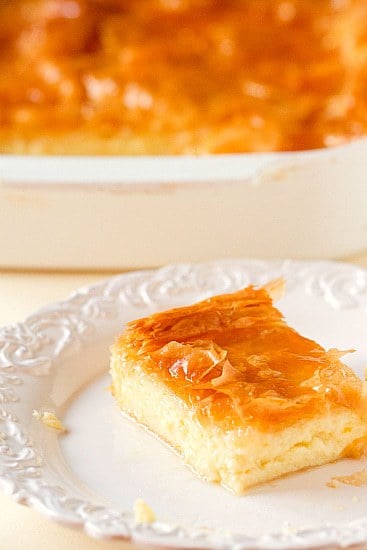
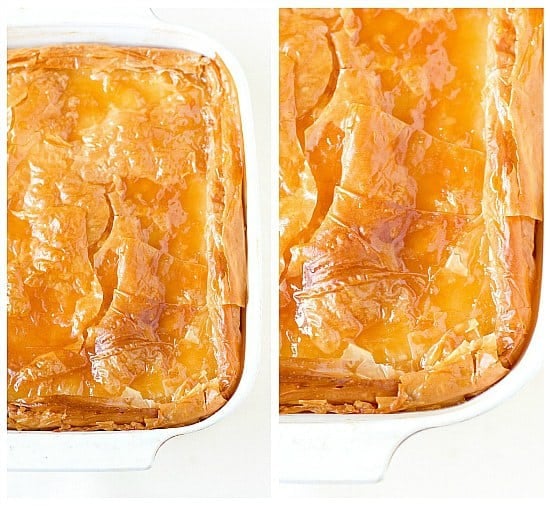
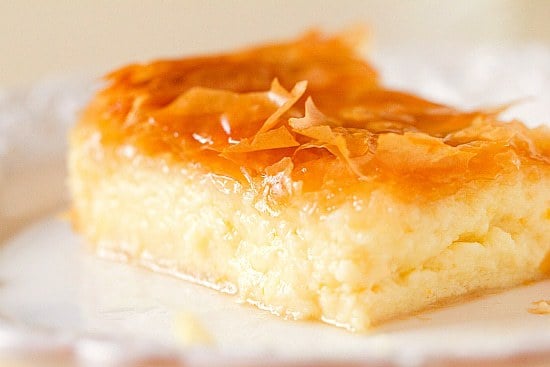
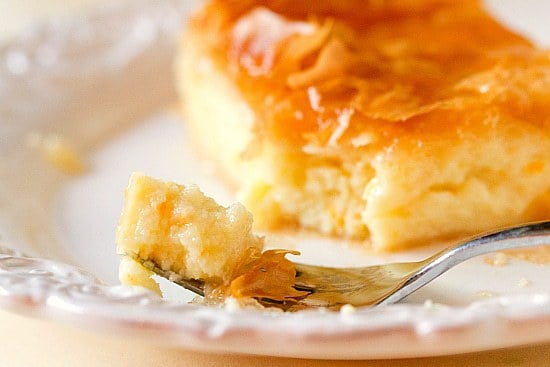



My godmother is lauded throughout my family for having the BEST galaktoboureko, everyone wonders what her recipe is… She just passed the tradition on to me, recommending YOUR recipe, it’s the closest thing to hers! This can only mean one thing, THIS recipe is so worth the time and effort! Thank you so much for writing and sharing this recipe Ms. Michelle, this will bring back so many memories and comforting desserts to come, especially when we can’t visit the family at the moment. I can’t wait to make a warm, sweet pan of goodness, thanks! <3
I followed a similar recipe from Rick Stein which unfortunately shares the same mistake. Adding egg to the mix which has recently been thickened on the job will result in the egg scrambling. You need to wait for the mixture to cool somewhat first.
A well constructed recipe with useful explanations. It tasted very much like the galaktobourekoi from the local Greek bakery. I easily halved the recipe for a test run but used a full recipe for the syrup and substituted lemon zest/juice for orange. As one reviewer commented, I agree that a little rosewater would be nice in place of the citrus. I have learned that the quality of phyllo dough is important. I bought mine a a Greek grocery and it was much easier to work with (more pliable and no cracking) and tastier than the name brand supermarket fare. Also, the pie wasn’t nearly as good the second day – IMO, it is good served at room temperature but should be eaten the day it is made.
Thanks, Brown Eyed Girl. :-)
Sounds fantastic. I saw a couple of other recipes that used corn starch instead of semolina. Would that work in yours, if so how much do u think?
Hi Ruth, I have not tried that substitution, so I couldn’t say for sure.
Hi, just thought I’d reply :) semolina is ground wheat and you can adjust the texture of the galaktoboureko custard with the coarseness of the grind. Corn starch would be too fine and possibly even taste gritty I think. There’s a different texture with a custard thickened with semolina, more of a stable custard but still melt-in-your-mouth. If a pudding was thickened so thickly with corn starch, I’m not sure it’d still have such a “melty” quality. This is all my own opinion though, just thought I’d share my experiences. Good luck! <3
The recipe came out looking just like the pictures and was enjoyed by everyone. I had some left that I put in the freezer I was thinking of defrosting it and putting it quickly in the oven to firm up the phyllo if it is soggy. Thoughts?
Hi just wondering on these recipes do you use whole egg or just yolk
Thanks
Jackie
Hi Jackie, If it says “eggs” then it is a whole egg, if you just need to use a yolk, then it will say “x egg yolks”.
I have gotten several definitions for semolina. Some call it flour, others a fine cream of wheat. Which is appropriate in this custard recipe?
The texture is more like a fine cream of wheat, but it’s referred to as flour. This is what I use: https://www.bobsredmill.com/semolina-pasta-flour.html
How far in advance can this assembled before baking? I think it’s best fresh but I have a time crunch the day I’m expected to bring it to a party.
I’d love to layer the phyllo and custard a day or two early and keep in fridge before baking it. Have you tried this? Will it turn out okay?
Hi Nancy, I have not tried to assemble this ahead of time and I’m not sure how it would fare – I’d be concerned that sitting that long would cause the phyllo to become extremely soggy and perhaps break down.
JUST found this recipe on your blog via your Pinterest board and immediately pinned it to mine :) . . . After reading your entry about this custard pie, I wondered if you have ever tried Moussaka? I know you’re a baker, and moussaka isn’t a sweet dish, but it is baked :) and is defined by the cinnamon that really makes this dish what it is – along with the eggplant. Since you were exited about making a Greek dish, I think moussaka would be a good one for you to add to your kitchen “try outs”. It is DELICIOUS! And would be a great on your Sunday Supper menus :)
Hi Michelle, I have made moussaka! Love it! My recipe is here: https://www.browneyedbaker.com/moussaka-recipe/
1) I would have put the sugar, course semolina and eggs, vanilla essence and beat them until nice and fluffy.
2) boil the milk with butter
3) adding heated milk with the semolina and stirring slowly adding milk and once both have been stirred together then continue to heat the two lots until fluffy & creamy.
4) add custard to filo pastry and follow heating instructions and when top is crispy light golden brown remove from oven and add syrup whilst hot and allow to cool.
Now you have authentic home made Greek Galatobouriko.
Regards
Anthony Sorotos
Hi – I’d like to try to do this is individual ramekins. I’m wondering how to adjust the cooking time? How do you know it’s ‘done’ – just by how brown the phyllo is or does the custard need to cook to a certain point as well?
Thanks!
Hi Sarah, You will definitely want to reduce the cooking time, but the recipe I used just went on the color of the phyllo… the custard needs to be set, as well, but it was done when the phyllo was golden brown.
You should try Bougatsa, it’s a different recipe but basically tastes like Galaktoboureko served warm and with cinnamon.
Great recipe! I’ve never had anything like it. Thank you for sharing!
Now THAT’s a dessert. I can’t almost taste it through the computer. Amazing!
Hi Michelle,
I’d love to make this for a weeknight dinner party, but I’m worried about the time it might take to put together after work. Do you think I could make the custard a day in advance? Thank you! Love your site and your recipes have never steered me wrong!
Hi Erica, Yes, you could, just bring it to room temperature before serving.
Hi Michelle, I’m trying to find semolina to make this. I have cream of wheat at home but that’s different right? The only other thing I have been able to find is semolina flour? Can I use that?
Hi Maleeha, Semolina flour is different, you do need to use actual semolina for this recipe.
Yum. Just made this….was looking for a way of using up part of a package of phyllo. I divided your recipe into thirds for my small family.. And this was perfect for an 8″ square baking pan. I also used dried milk and dried egg……and it worked beautifully. Thanks!
As a Greek person , born and raised , i cant stop my self from pointing out some “mistakes” in the recipe. Original Galatopoureko has rosewater in the custard instead of vanilla extract, and no orange zest.. And in the syrup, there’s no orange just sugar water SOME lemon for the smell cinnamon sticks and cloves … :)just saying..
I just had this at a Greek friend’s house – his Mom made it for his name day because it’s his favorite dessert ever. I’d never heard of it, and they said the name so fast that all I heard was galactosomething.
LOVED. IT. googled when I got home and here it is…I’m trying this recipe out fo sho.
Thanks Michelle, from a fellow baker with brown eyes :)
If you keep the pastry covered with a damp cloth whilst you are working with it, you won’t have any problems with it drying out and cracking.
Thank you for your wonderful galaktobouriko recipe ! …..We are It’s All Greek To Me a specialist mobile fresh food trailer serving chargrilled meats/ Haloumi Cheese in flatbreads with salad at music festivals & events throughout the UK . We sell Baklava ( homemade) on our unit & now I have added this to our menu , it’s already very popular & soon sells out !!
February 15, 2013
Hi, congratulations for this dessert. I’m from Panama and, I like very much Galaktobureko — is delicious…! When I saw de photo I felt I had a piece of it in my mouth… Thank you for the recipe.
I also love Baklava…pls get me the recipe.
Thank you very much…
Hi Marcia, Here is the link for my baklava recipe: https://www.browneyedbaker.com/2012/09/12/baklava/
Try instead of orange juice for the syrup – the juice from half a lemon! and another very important thing is – either pastry should be cold and syrup warm or the other way around!
My hubby loves “the galactic treat” (his name for it since it is hard to pronounce). Only difference I do is lemon and cinnamon instead of orange. Might have to try this one.
I have been making this for years, starting back when I married into a Greek family. My special twist is adding Grand Marnier and orange zest to the syrup.
Yum!
This is especially for Eleni and Michelle: Please, please when you are getting recipes from your elders, videotape them! Record them any way possible! I did it when my mom made her wonderful stuffing for turkey because she never measured anything and I use that recording every Thanksgiving! She is no longer with us and I would be lost without her voice guiding me in the steps to making the most delicious stuffing in the world! It was the smartest thing I ever did 16 years ago. Believe me, you won’t regret it.
Such a great suggestion! I wish I had thought to do this before my grandma passed away!
What a blessing that must be that you have your mother with you every Thanksgiving to “help” with the stuffing. What a fabulous idea and thank you for sharing!
This is my favourite Greek dessert (although we make it with honey instead of orange juice in the syrup). An extra tip to make the presentation nice which my mum taught me is to lightly score the top of the pie with a knife both ways (like a checkerboard) before putting it in the oven; this will make the top fillo leaves come apart evenly instead of breaking up whichever odd way they please. You can also garnish each piece with a clove (useful when needing to cover so the leaves won’t stick). Also, beware of buying this dessert from cafés or restaurants… they often use cornflour instead of semolina because it’s cheaper.
Thank you so much for the tip!
My mom used to have a thing for this dessert – every single time we went to this great Greek restaurant near the World Trade Center in NYC, she would order some when she walked in the door. If they didn’t have any, she would be disappointed. I had never eaten it there even though she always wanted to share.
I have always had trouble working with phyllo but I think I am going to try this one of these days. To see what Mom liked about it. The custard? Maybe that was it. Or the crispy phyllo with the custard? I don’t know – I will see.
Thanks for sharing. Looks so good.
Just had to tell you how awesome this was. I made it this week and it was excellent and very simple. My Greek husband, whose favourite greek dessert is galaktoboureko, loved it. I will definitely make this again. Thank you.
Is this served best hot or can it be made the day before?
Hi Debbie, You can make this the day before but I would bring it to root temperature before serving.
That first photo is absolutely gorgeous. I am a custard lover (oh my flan), and this would be so impressive at a potluck or something. I’ve never made anything that was authentic Greek either! Guess we should all start somewhere, why not dessert?
YUM!!! Thanks for this. I am half greek but none of the recipes were passed on so I have nothing. Any more greek recipes you have, please share!! Everything you make is so good!
I’ll have to try this! I recently bought Vefa’s Kitchen which is considered the bible of Greek cooking because I want to cook more Greek food. I’d have to say my favorite Greek dish is Souvlaki. Probably because that was my introduction to Greek food when I was in. Athens in 1979. Made the experience even better because I got it from a walk up window. I also love Gyros, Pasticcio, and Spanekopita. Excuse any incorrect spelling. I’m not able to look up the words at the moment.
Hi Barbara, Thanks for sharing that book recommendation – I just added Vefa’s Kitchen to my Amazon wish list!
Looks and sounds divinely delicious! I’ll make it next time I have guests to impress. :)
If I didn’t love you before, I definitely love you now. I always get this when we go to Hella’s in Indianapolis. Your pics look like it is identical to what they serve. I cannot wait to make this. Thanks!
This looks delicious. I am a massive fan of custard tarts, but never had something like this. Must try this.
Nice recipe! :)
the flaky custard goodness is making me want to forget my january diet and dig in!
This sounds amazing and I’d never heard of it before. I LOVE baklava, and here’s my recipe for it: http://www.culinarythymes.com/melt-in-your-mouth-baklava/
It’s made with pistacios. Have a great weekend and thanks for posting this recipe!
Thank you for sharing I will definitely have to try this recipe!
Yum! This is my favorite Greek dessert!! I have always wanted to make this. Thanks for the great recipe. I hope it stands up to my boyfriends family’s recipe!
I totally get like that too. I have ALL these recipes I want to try, and then I go to pick one out and nothing is ever interesting. Those days are lame. This looks totally awesome though! I love Greek food!
I cannot WAIT to make this! I’m making a whole Greek meal next week for my family (who are Italian, not Greek – but close). I found a great pastitsio recipe (Greek Lasagna) if you’re interested…She has a lot of great authentic Greek recipes!
http://www.orthodoxmom.com/2009/09/greek-pastitsio-recipe.html
I have never heard of thism but it looks really interesting! In a good way! I think i’ll have to make it!
Interesting. Just this past Sunday, Brian and I took his mother out to lunch at a Greek restaurant and she ordered this for dessert. I’d never tried it so I tasted hers and it had an anise flavor to it which I didn’t care for. Your recipe sounds more to my liking. Thanks :)
This looks so delicious, I love Greek food, I Mr GG and I were really into making Baklava there for a while only we had to stop while our clothes still fit us. This is on my “must make list”
This looks absolutely delicious! I LOVE the idea of a citrus syrup on it! My favorite Greek food is savory -spanikopita – but I’ve never made it!
Wow, this looks so amazingly good. I love custard by itself, but with the phyllo and syrup on top this looks just divine.
this looks so good! especially the flaky top. i have the same problem sometimes. my to-bake list is sooo long but i still dont know what to bake!
I love, love, love, love, love Galaktoboureko. I live in a predominantly Greek neighbourhood, so there’s there’s a local bakery that makes an absolutely addictive version of it (along with some other amazing savoury pies and a kind of honey-soaked fritter that is beyond heavenly).
I’ve been too wussy to try making it at home, seeing as I can get a great ready-made version whenever I want, but it really does look quite easy… might just have to give it a go next time I feel like fussing with some phyllo dough. :)
“Honey soaked fritter” sounds like loukoumades to me! They’re absolutely delicious! Little fried dough balls slapped with a thin honey simple syrup while still hot and rolled in crushed nuts (we use pistachios, but I’ve seen variations). YUM! I’m Greek but I’ve never made galaktoboureko so I’m definitely saving this recipe!
Your chief culinary consultant definitely came through with flying colors on this one. It looks fantastic, Michelle! I love your lighting in these photos.
this looks beautiful. i am a sucker for custard. i know weird but i love it. I have never even heard of galakoboureko. That’s one thing i love about food blogging you hear about food you never would have heard about otherwise.
Mmmmmm….that looks so good! I already have everything needed except the Semolina. Having recently gone on the hunt for Semolina for some Basbousa, I need to clarify- is this Semolina of Semolina Flour? It’s all Greek to me. (pun intended) :)
Hi Michele – It is semolina, it sort of looks like what you would use for pastina – a fine porridge type of breakfast cereal.
Cream of Wheat type thing?
Yes, although don’t use Cream of Wheat!
Pastitsio is a favorite around our house, but we can’t seem to find a definitive “best” recipe for it. We keep trying new recipes and modifying and combining the best parts of each recipe. Hopefully someday we’ll find just the right mix of spices, etc for all the elements of this dish, but until then it’s fun to taste test our efforts!
Thanks! – bri <3
Gosh I wish I lived close to you!!! Who does all this food go to when you make it?
Aw, thank you! It makes its rounds – family, friends, my mom takes a lot to share with her coworkers, etc.
This sounds so yummy, but when you are trying to lose weight, this would not be good!!
That pastry looks perfect! The citrus syrup sounds divine…
xo
http://allykayler.blogspot.com/
Ok…this looks seriously delicious. Your pictures are beautiful and it has all of my favorite ingredients. Great post! Another bookmark for me!
This is one of my all time favorites. And your recipe is dead-on. The only thing I do different is cutting the top layer of the phyllo dough before I bake the gallaktobureko. Makes it easier to cut once baked (without the crumbling of the phillo).
And yes, whilst it might be a bit time consuming, the result is definitely worth your while :)
That looks divine! I love greek food and we have a huge greek culture with tons of restaurants here in MI. Moussaka, lemon rice soup, this amazing lamb in tomato sauce (can’t remember the name!) and a good greek salad with chicken are my favorites. I am not a huge honey fan and usually don’t get dessert, but I will look for this on the menu next time! Or try making it myself :)
Michelle:
I know what you mean, only sometimes I have to throw in “no motivation to cook”
Do you think your CCC could do some planning for me??
You are so fortunate to have him!
Charlie
OMG…Thank you for this recipe! I have been obsessed with this dessert since the 1st time that I tasted it at the Greek Festival last year.
!ooh, anything Greek and I’m THERE!! I think I must have been Greek in a previous life, either that or Italian.
This is bookmarked to try REAL soon! Thanks, Michelle!
My absolute favorite dessert! I’m so excited to try this!
I am the worse when it comes to working with Phyllo dough, I guess I should keep practicing. This greek pie looks amazing!!
I had this on Christmas for the first time and loved it! I’m so happy that I can make it myself now!!
So GORGEOUS!! Phyllo dough + Custard is a glorious combination!!
My fave Greek dessert!! my godmother makes the BEST ive ever had, but of course the recipe is all in her head!! I’m excited to give this a try!
Eleni–Get her to make it while you are there and you measure and write it down! My grandmother died with all her recipes in her head. My mom says they were great. So when my aunt got cancer and was making cabbage dolma, my cousin and I went and watched, measured and wrote down. It may be the only way….
Stuffed grape leaves. Time consuming, but delicious and there are so many variations that you can usually please the palates of most diners.
Can’t wait to make this, looks delicious!
I have never made a Greek dessert. This sounds delightful and looks absolutely beautiful!
Wow, this sounds awesome! I’ve never even heard of this, I love that bloggers always introduce me to new foods :)
I feel the same way! I’ve never heard of this either but it sure does look interesting.
I also love classic home recipes from other places! Greek recipes are so lovely. I worked with a Greek guy for a summer and he opened my eyes to so many unique and tasty foods! Can’t wait to try this! My favorite greek dish is spanikopita!
Here is my recipe for moussaka, it is wonderful http://seeminglygreek.com/2011/06/moussaka/
Also, I love a veggie pastitsio every once in a while too
http://seeminglygreek.com/2011/04/vegetarian-pastitsio/
Your photos turned out great! We love this dessert too, but only make it when we have friends to share with :)
Saw your recipe and would love to try it. My father in law is a vegetarian and I wondered if I could double either the eggplant or the potatoes (or maybe add an additional veg like zucchini) to this recipe. He does eat dairy and unfertilized eggs.
Michelle, Leave it to you. You always come up with something delicious and different. I have always had this dish served in their individual rolls. I like this idea better…seems easier. I will make this when I have my parents over for dinner. My dad worked 24 years for a greek newspaper in NYC.
Not that your chief culinary consultant ins’t doing excellent work, but I’m very envious of his job..these look great.
I love galaktobouriko! When I was in Greece as a child I stuffed my face with it! Your’s looks amazing, I’ll definitely have to try this one :)
My favorite Greek recipe would have to be avgolemono.
This is my absolute all time favorite greek dessert! I havent made this since pastry school and now I cant wait to make it again!! Thanks :o)
your photographs have the wow factor as well!
your greek custard pie looks delicious.
I have never heard of this before but it looks exquisite :)
Very exotic!
Whenever I see a recipe from the Mediterranean my palms start to sweat as I get nervous around filo dough. It’s a fear I have yet to concur. Perhaps this glorious dessert — which I have definitely enjoyed in Greek restaurants — will be the key to unlock and disarm my fear.
I don’t know if you have a Safeway near you, but their phyllo dough is the best. I use it all the time and have never had a problem with it drying out or cracking.
I know this is 6 years later and I hope you have conquered your fear, but if not, I have to tell you, phyllo is VERY forgiving! Even if it tears, you can patch it back together with another sheet and a little butter and it jut adds to the texture.crunch factor
I can relate to the picking recipes and then having off days where nothing sounds good. It looks like you picked the right one though because this sounds and looks delicious. Yummy!
Wow this looks glorious! I love the glowing amber color…so tempting and delish looking!
My fave greek dessert is…baklava. Or this…i have to try it!
ONLY rival is creme de brulee – can not decide – BOTH heavenly!!
My favorite dessert ever! Thank you so much for the recipe! :)))